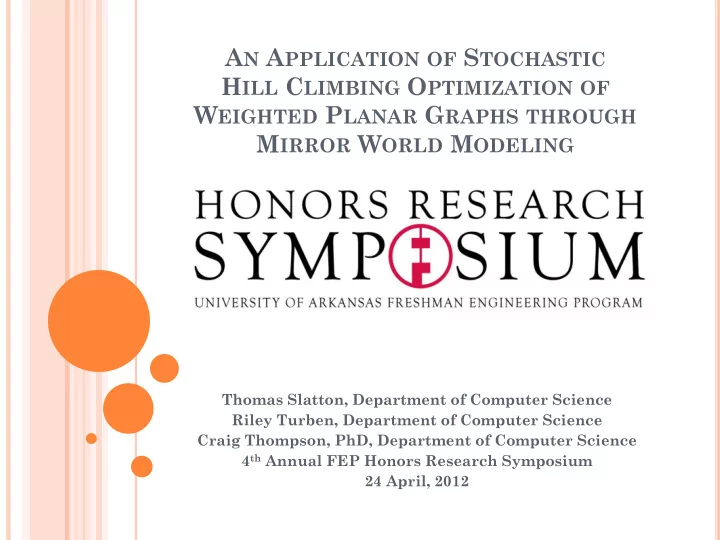

A N A PPLICATION OF S TOCHASTIC H ILL C LIMBING O PTIMIZATION OF W EIGHTED P LANAR G RAPHS THROUGH M IRROR W ORLD M ODELING Thomas Slatton, Department of Computer Science Riley Turben, Department of Computer Science Craig Thompson, PhD, Department of Computer Science 4 th Annual FEP Honors Research Symposium 24 April, 2012
T HE P ROBLEM A REA How can the University of Arkansas pathway system be redesigned to achieve an optimized configuration of paths? 2 Slatton, Turben. 4 th Annual FEP Honors Research Symposium
O PTIMALITY How can anyone be sure what they choose is better than another option? Optimization Making changes that increase the value of a system 3 Slatton, Turben. 4 th Annual FEP Honors Research Symposium
D EFINING O PTIMALITY A system that uses the same amount of pathway and has a lower average travel time A system that has the same average travel time and a lower amount of pathway A combination of lowered average time and lowered distance 4 Slatton, Turben. 4 th Annual FEP Honors Research Symposium
R EPRESENTING THE U NIVERSITY OF A RKANSAS P ATHWAY S YSTEM In what way can the University of Arkansas and its pathway system be represented virtually to allow for optimization? 5 Slatton, Turben. 4 th Annual FEP Honors Research Symposium
G RAPHS Node – A point at which edges meet Intersections of pathways and building entrances Edge – A connection between nodes The paths themselves Weight – The value assigned to an edge, often the length of that edge The amount of time it takes to walk a path Graph – A series of nodes and edges The entire pathway system Planar Graph – A graph that can be represented on a plane such that no edges cross (Weisstein 1999) 12 7 5 7 6 7 5 5 6 Slatton, Turben. 4 th Annual FEP Honors Research Symposium
B UILDING A G RAPH Elevations Speed vs. Inclination Building locations 3.5 (meters/second) 3 Path locations 2.5 Speed Walking speed 2 1.5 1 0.5 0 -35 -30 -25 -20 -15 -10 -5 0 5 10 15 20 25 30 35 Inclination (degrees) 7 Slatton, Turben. 4 th Annual FEP Honors Research Symposium
O PTIMAL R OUTING What is the most efficient way to walk from one place on the University of Arkansas campus to any other place using pedestrian walkways? 8 Slatton, Turben. 4 th Annual FEP Honors Research Symposium
B READTH -F IRST S EARCH WITH P RIORITY Q UEUE 9 M. Barbehenn, "A Note on the Complexity of Dijkstra's Algorithm for Graphs with Weighted Vertices," in IEEE Transactions on Computers , IEEE Slatton, Turben. 4 th Annual FEP Honors Research Symposium Computer Society, 1998, vol. 47 pp. 263 .
O PTIMIZATION How could the pathway system be redesigned to yield a more efficient model? 10 Slatton, Turben. 4 th Annual FEP Honors Research Symposium
S TOCHASTIC H ILL C LIMBING Hill Climbing Making incremental changes to yield an increase in the output of the value function Stochastic Hill Climbing Changes do not necessarily yield the largest possible increase in value 11 S. Derbyshire. (2008, February 21). MaximumParabaloid.png [Online]. Available: http://en.wikipedia. org/wiki/File:MaximumParabo Slatton, Turben. 4 th Annual FEP Honors Research Symposium loid.png
S TOCHASTIC H ILL C LIMBING (C ONT ’ D ) I. Ljubić and G. R. Raidl , “An Evolutionary Algorithm with Stochastic Hill-Climbing for the 12 Edge-Biconnectivity Augmentation Problem” in Applications of Evolutionary Computing , Vol. 2037. Berlin, Germany, Springer-Verlag, 2001, Slatton, Turben. 4 th Annual FEP Honors Research Symposium ch. 3 , sec. 4, pp. 20-29 .
R ESULTS University of Arkansas as it is 37.9 kilometers of pathway 305.5 second average travel time Optimized graph 37.8 kilometers of pathway 277 second average travel time 13 Slatton, Turben. 4 th Annual FEP Honors Research Symposium
A VERAGE T IME A S A F UNCTION OF T OTAL P ATHWAY L ENGTH Average Travel Time as a Function of Total Length 390 Average Travel Time 370 350 (seconds) 330 310 290 270 250 15000 20000 25000 30000 35000 40000 Total Pathway Length (meters) 14 Slatton, Turben. 4 th Annual FEP Honors Research Symposium
O THER A PPLICATIONS Related network analysis applications: Roads and Highways Virtual routing Videogame artificial intelligence Circuit design Emergency evacuation simulations Direct on-campus applications: Optimal locations for bulletin boards, emergency phones, or other public-use devices Adding new pathways 15 Slatton, Turben. 4 th Annual FEP Honors Research Symposium
R EFERENCES I. Ljubić and G. R. Raidl , “An Evolutionary Algorithm with Stochastic Hill-Climbing for the Edge-Biconnectivity Augmentation Problem” in Applications of Evolutionary Computing , Vol. 2037. Berlin, Germany, Springer-Verlag, 2001, ch. 3 , sec. 4, pp. 20-29 . M. Barbehenn, "A Note on the Complexity of Dijkstra's Algorithm for Graphs with Weighted Vertices," in IEEE Transactions on Computers , IEEE Computer Society, 1998, vol. 47 pp. 263 . P. E. Boas et.al. , “Design and Implementation of an Efficient Priority Queue” in Theory of Computing Systems , Springer-Verlag, 1976, vol. 10. pp. 99-127. D. Eppstein. (2002, March 8). Priority Dictionary [Online]. Available: http://code.activestate.com/recipes/117228- priority-dictionary/ 16 Slatton, Turben. 4 th Annual FEP Honors Research Symposium
Recommend
More recommend